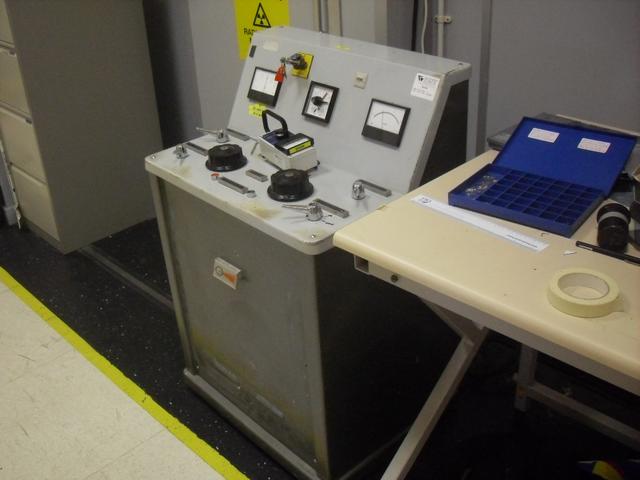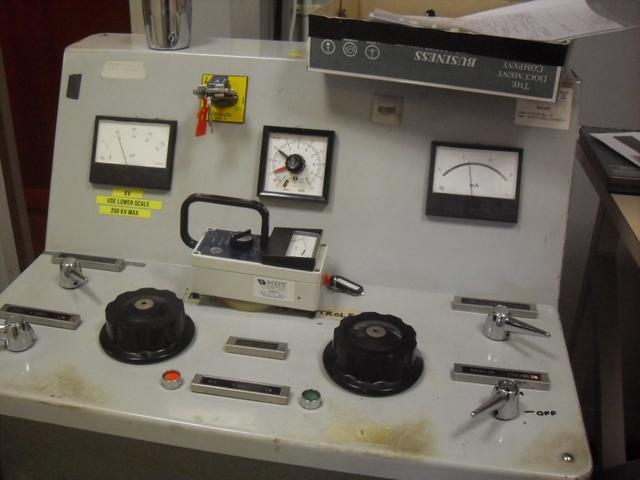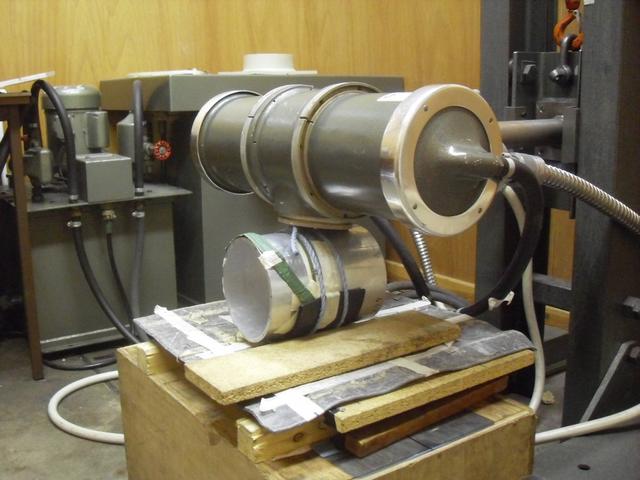Radiography - pre-electronic vs. computer-controlled
An electro-mechanical X-ray kit
This is the late 1960's (?) "Pantak Windsor" X-ray machine I used at
TWI-N.
The console...


The X-ray head and power-unit behind...

Pre-electronic X-ray compared to computer-control X-ray kit
With computer-controlled X-ray equipment
- Key-in the desired Voltage (kV), current (mA) and duration of shot
in seconds or minutes and seconds
- The computer will check the values are allowable and alert if they
are "out of range" for the equipment - it will not act on such
inputs
- The computer will also assert if a "warm-up" is needed - such as
when significantly increasing the Voltage
- To take the X-ray shot you simply press the green button and
everything is done for you
With this pre-electronics equipment
- Voltage (kV) and Current (mA) are controlled by the two rotary
control knobs. They don't have a scale and you have to watch the
meters on the console as you turn the control-knobs. Then action of
each control is not independent. If you change just the voltage
setting the current is affected. Same for the current control - the
voltage is affected. So you have to turn both knobs simultaneously,
watching both kV and mA.
- You have to set-up the current and voltage for the next shot
before you set-up your component and film under the X-ray head.
Because there is no scale for kV and mA - there cannot be, as they
float around in a complex relationship - you have to set the machine
running and adjust the voltage and current controls until you reach
the desired values. You can then stop the machine on the red button
and go set up your shot.
(you cannot have your next X-ray film in place during voltage /
current setup! - it would be getting exposure from the X-rays!!!)
- There is a timer with an analogue dial for length of shot. You
can switch it between dial-means-seconds and dial-means-minutes. But
there is a red outer scale for seconds and a black inner scale for
minutes.
- When you have set up your shot, when you press the green button
for go, the machine should ramp up to the voltage and current settings
you obtained in set-up. But there can be a slight drift and you often
have to fine-tune the kV and mA (it would be a rare chance that in
adjusting one to correctness the other also became correct!). The
"drift" tends to be greater the longer the time from set-up to running
a shot.
- You have to know the warm-up procedure and do it manually. This
is to limit thermal shock to the tube and to "burn" contaminant gases
out of the cathode to anode path area. You do the warm-up on broad
focus (size of the target spot on the anode - yes another manual
control!)
On the other hand, this machine has a far wider range of tube voltage
down to very low voltages - it will run stable at 25kV - whereas I
have met computer-controlled machines which will not go below 70kV.
70kV is above the maximum allowable X-ray tube voltage by specs such
as BSEN1435 for many Aluminium components. Let alone the desired
voltage for maximum resolution! The power of 6mA on fine-focus of
1.5mmx1.5mm target area is quite good.
So overall, you have to know and nurture the machine, but it gives
lovely results.
Another thing - there's also sorts of "clunks", "whirrs", "clicks" and
"tickings" of various loudnesses as this machine operates - whereas
computer-controlled do not entertain with any sounds at all apart from
the intended alerting bleeps.
R D Smith, 18 July 2010



